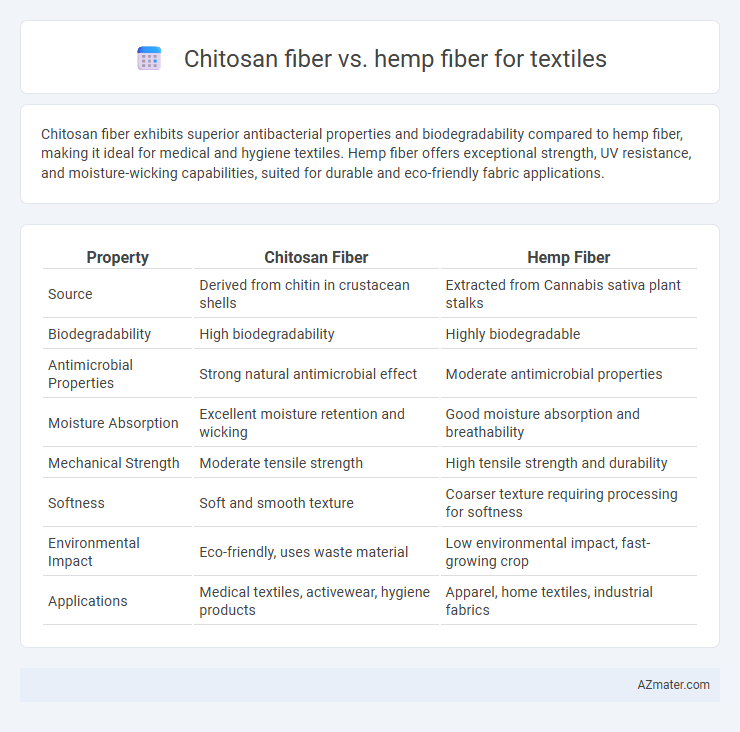Chitosan fiber exhibits superior antibacterial properties and biodegradability compared to hemp fiber, making it ideal for medical and hygiene textiles. Hemp fiber offers exceptional strength, UV resistance, and moisture-wicking capabilities, suited for durable and eco-friendly fabric applications.
Table of Comparison
| Property | Chitosan Fiber | Hemp Fiber |
|---|---|---|
| Source | Derived from chitin in crustacean shells | Extracted from Cannabis sativa plant stalks |
| Biodegradability | High biodegradability | Highly biodegradable |
| Antimicrobial Properties | Strong natural antimicrobial effect | Moderate antimicrobial properties |
| Moisture Absorption | Excellent moisture retention and wicking | Good moisture absorption and breathability |
| Mechanical Strength | Moderate tensile strength | High tensile strength and durability |
| Softness | Soft and smooth texture | Coarser texture requiring processing for softness |
| Environmental Impact | Eco-friendly, uses waste material | Low environmental impact, fast-growing crop |
| Applications | Medical textiles, activewear, hygiene products | Apparel, home textiles, industrial fabrics |
Introduction to Chitosan and Hemp Fibers
Chitosan fiber, derived from chitin in crustacean shells, offers natural antibacterial properties, biodegradability, and moisture management, making it ideal for advanced textile applications. Hemp fiber, obtained from the stalks of the Cannabis sativa plant, is renowned for its exceptional durability, breathability, and environmental sustainability due to low water and pesticide requirements. Comparing chitosan and hemp fibers reveals distinct advantages in biofunctionality and eco-friendliness, driving innovation in sustainable textile manufacturing.
Origin and Source Materials
Chitosan fiber is derived from chitin, primarily sourced from the exoskeletons of crustaceans such as shrimp and crabs, providing a renewable and biodegradable option in textiles. Hemp fiber originates from the stalks of the Cannabis sativa plant, known for its strength and durability, making it an eco-friendly and sustainable choice. Both fibers emphasize natural origins, with chitosan leveraging marine byproducts and hemp utilizing fast-growing terrestrial plants.
Fiber Extraction and Processing Methods
Chitosan fiber is derived from chitin found in crustacean shells through deacetylation and wet spinning, resulting in a biocompatible, antimicrobial textile material with complex extraction involving chemical treatments. Hemp fiber extraction involves mechanical and chemical retting processes to separate bast fibers from the stalk, producing coarse yet strong fibers suitable for durable fabric production. Both fibers require specialized processing: chitosan fibers need controlled pH and solvent conditions during spinning, while hemp fibers demand retting optimization to improve fiber quality and textile uniformity.
Physical and Mechanical Properties
Chitosan fiber exhibits excellent biodegradability, high tensile strength, and superior elasticity, making it ideal for sustainable textile applications. Hemp fiber offers remarkable durability, abrasion resistance, and moisture-wicking properties, often surpassing other natural fibers in tensile strength and stiffness. Both fibers contribute to eco-friendly textiles, but chitosan fibers provide enhanced antimicrobial properties, while hemp excels in mechanical toughness and environmental resilience.
Environmental Impact and Sustainability
Chitosan fiber, derived from chitin found in crustacean shells, offers a biodegradable and renewable alternative with inherent antimicrobial properties, reducing the need for chemical treatments in textiles. Hemp fiber is highly sustainable, requiring minimal water and pesticides while improving soil health through crop rotation and carbon sequestration, making it a low-impact fabric choice. Both fibers contribute to eco-friendly textile production, but hemp's large-scale agricultural benefits and chitosan's waste valorization from seafood processing highlight distinct environmental advantages.
Comfort and Wearability in Textiles
Chitosan fiber offers superior moisture absorption and antimicrobial properties, enhancing comfort by keeping skin dry and reducing odor in textile applications. Hemp fiber, known for its strength and breathability, provides excellent thermal regulation and durability, which improves wearability in various climates. Combining chitosan's bioactive features with hemp's robustness creates textiles with balanced comfort and long-lasting performance.
Biodegradability and End-of-Life Considerations
Chitosan fiber exhibits excellent biodegradability, breaking down quickly in natural environments due to its polysaccharide-based structure, which supports sustainable end-of-life disposal with minimal environmental impact. Hemp fiber is also highly biodegradable because of its natural cellulose content, decomposing effectively in soil and contributing to closed-loop textile systems. Both fibers offer environmentally friendly end-of-life options, but chitosan fiber's antimicrobial properties enhance its performance in reducing waste-related issues during degradation.
Industrial Applications in the Textile Sector
Chitosan fiber offers antimicrobial properties and excellent moisture absorption, making it ideal for medical textiles and hygiene products in the industrial textile sector. Hemp fiber boasts high tensile strength, durability, and biodegradability, widely used for eco-friendly industrial fabrics and heavy-duty textiles. Industrial applications leverage chitosan's bioactivity for functional textiles, while hemp provides sustainable alternatives for workwear, upholstery, and geotextiles.
Cost Comparison and Market Availability
Chitosan fiber, derived from crustacean shells, generally incurs higher production costs due to complex processing and limited raw material availability, resulting in a higher market price compared to hemp fiber. Hemp fiber benefits from widespread cultivation, lower production expenses, and established supply chains, making it more cost-effective and readily available for textile manufacturing. Market demand for sustainable textiles drives gradual growth in chitosan fiber availability, but hemp fiber remains dominant due to its affordability and accessibility.
Future Prospects and Innovation in Fiber Technology
Chitosan fiber exhibits promising future prospects in textile innovation due to its inherent antibacterial, biodegradable, and moisture-retentive properties, making it ideal for medical, sportswear, and eco-friendly applications. Hemp fiber remains a strong contender with its renewable, high-strength, and UV-resistant characteristics that enhance durability and sustainability in eco-conscious fashion and technical textiles. Advancements in blending chitosan with hemp and other natural fibers are driving next-generation textiles that combine superior functionality with environmental benefits, positioning these fibers at the forefront of green textile technology.

Infographic: Chitosan fiber vs Hemp fiber for Textile
 azmater.com
azmater.com